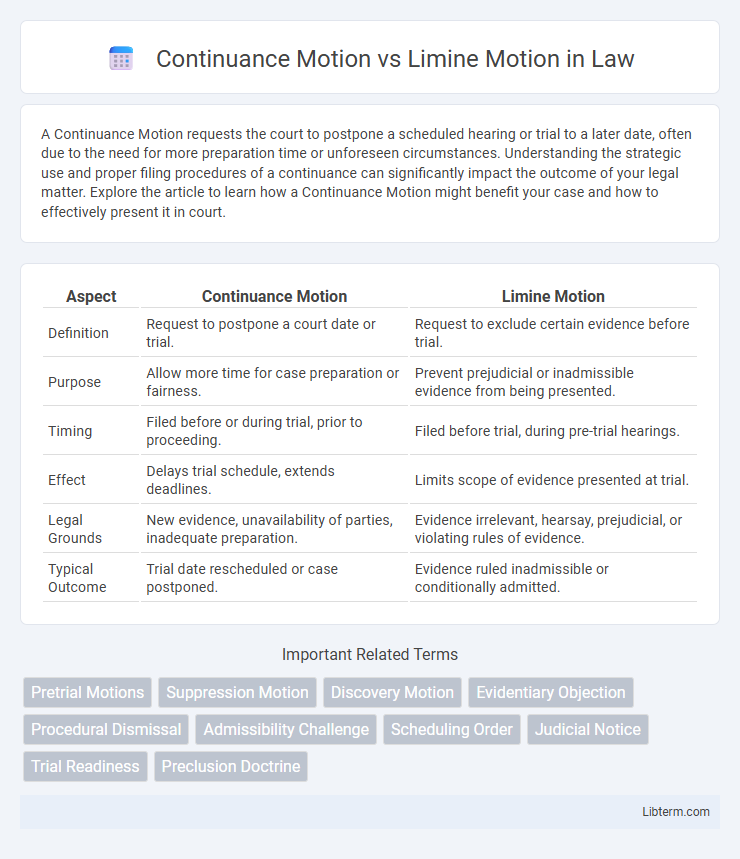A Continuance Motion requests the court to postpone a scheduled hearing or trial to a later date, often due to the need for more preparation time or unforeseen circumstances. Understanding the strategic use and proper filing procedures of a continuance can significantly impact the outcome of your legal matter. Explore the article to learn how a Continuance Motion might benefit your case and how to effectively present it in court.
Table of Comparison
| Aspect | Continuance Motion | Limine Motion |
|---|---|---|
| Definition | Request to postpone a court date or trial. | Request to exclude certain evidence before trial. |
| Purpose | Allow more time for case preparation or fairness. | Prevent prejudicial or inadmissible evidence from being presented. |
| Timing | Filed before or during trial, prior to proceeding. | Filed before trial, during pre-trial hearings. |
| Effect | Delays trial schedule, extends deadlines. | Limits scope of evidence presented at trial. |
| Legal Grounds | New evidence, unavailability of parties, inadequate preparation. | Evidence irrelevant, hearsay, prejudicial, or violating rules of evidence. |
| Typical Outcome | Trial date rescheduled or case postponed. | Evidence ruled inadmissible or conditionally admitted. |
Introduction to Pretrial Motions
Pretrial motions are essential tools in civil and criminal litigation, used to clarify issues and streamline the trial process. A continuance motion requests the court to delay the trial date, often due to the need for more time to prepare or gather evidence. In contrast, a motion in limine seeks to exclude certain evidence from being presented at trial, aiming to prevent prejudicial or irrelevant information from influencing the jury.
What is a Continuance Motion?
A Continuance Motion is a legal request filed by a party seeking to postpone a court proceeding to a later date, often due to the need for additional time to prepare the case, gather evidence, or secure witness availability. This motion aims to ensure fairness and adequate preparation, preventing trial delays from prejudicing either side. Courts evaluate Continuance Motions based on reasons provided, timeliness, and potential impact on the judicial process.
Purpose and Scope of Continuance Motions
Continuance motions primarily serve to request postponement of court proceedings to ensure adequate preparation time or availability of key parties, witnesses, or evidence. They aim to prevent prejudicial trial delays by addressing unexpected circumstances that hinder timely case progression. Unlike limine motions that exclude specific evidence before trial, continuance motions affect the overall schedule and procedural timeline of the case.
What is a Motion in Limine?
A Motion in Limine is a pretrial request that seeks to exclude or limit certain evidence from being presented during a trial to prevent potential prejudice or inadmissibility. Unlike a continuance motion, which requests a postponement of the trial, a motion in limine addresses specific evidentiary issues before the courtroom proceedings begin. This motion helps streamline the trial process by resolving disputes over evidence admissibility in advance, ensuring a fair and efficient trial.
Key Differences Between Continuance and Limine Motions
Continuance motions request a postponement of a trial or hearing to allow more time for case preparation, often citing the need for additional evidence or witness availability. Limine motions seek to exclude specific evidence or testimony from being introduced at trial, aiming to prevent prejudicial or irrelevant information from influencing the jury. The key difference lies in continuance motions addressing timing and procedural delays, while limine motions focus on controlling evidentiary content before trial begins.
Legal Standards for Granting Continuance Motions
Continuance motions are granted based on factors such as the reason for the delay, potential prejudice to parties, and docket congestion, aiming to ensure fairness and due process. Courts evaluate whether the requesting party acted with diligence and if the continuance serves the interest of justice without causing undue delay. In contrast, motions in limine are pretrial requests to exclude certain evidence, focusing on admissibility rather than scheduling or procedural fairness.
Legal Standards for Granting Motions in Limine
Motions in limine request pretrial rulings to exclude or admit specific evidence based on legal standards such as relevance, prejudice, or hearsay under the Federal Rules of Evidence. Courts grant motions in limine when evidence is deemed inadmissible or likely to cause unfair prejudice, ensuring a fair trial by preventing improper evidence from influencing the jury. The standard requires a showing that the evidence lacks probative value or its prejudicial effect substantially outweighs its probative worth, aligning with Rule 403 of the Federal Rules of Evidence.
Strategic Uses of Each Motion in Litigation
Continuance motions strategically delay trial dates to allow parties more time to gather evidence or secure key witnesses, enhancing case preparation and increasing the likelihood of favorable outcomes. Limine motions are used to exclude prejudicial or irrelevant evidence before trial, preventing jurors from hearing damaging information that could bias their judgment. Employing continuance motions can buy critical preparation time, while limine motions streamline trial focus and protect trial fairness by shaping the evidentiary landscape.
Common Challenges and Pitfalls
Continuance motions often face challenges such as proving good cause for delay and managing court schedules, while limine motions commonly encounter pitfalls related to overly broad or vague requests excluding critical evidence. Both motions require precise legal standards and thorough preparation to avoid judicial denial or unfavorable rulings. Attorneys must carefully balance the necessity of continuance against prejudicing the opposing party and justify limine motions with clear relevance and admissibility criteria under rules of evidence.
Conclusion: Choosing the Right Pretrial Motion
Selecting the appropriate pretrial motion depends on the specific case circumstances and strategic objectives. Continuance motions are optimal for requesting additional time to prepare or gather evidence, while motions in limine effectively exclude prejudicial or inadmissible evidence before trial. Lawyers should evaluate the timing, purpose, and potential impact of each motion to enhance trial readiness and protect their client's interests.
Continuance Motion Infographic

 libterm.com
libterm.com